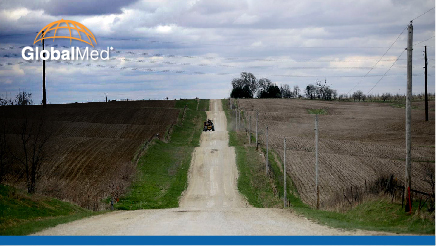
COVID-19 has arrived in rural America, threatening the livelihoods of its most vulnerable residents. Many rural communities have an older, poorer population, and limited hospitals and medical staff.
A Kaiser Health News study found that overall, 18 million people live in counties that have hospitals but no ICU, and about a quarter of those people are over the age of 60. In Nebraska, for example, 81 counties don’t have a single ICU bed and sending even a few nurses or doctors into quarantine could quickly leave hospitals and clinics with no medical professionals at all.
Telehealth can answer the call to solving this critical gap in care and many patients and providers are anxious to experience its benefits. But there’s still one hurdle to overcome in many rural areas – Internet connectivity. The Federal Communications Commission (FCC) reports that 31 percent of American rural households still lack access to broadband Internet. Neilsen Online reports 43.2 percent of the world’s population doesn’t use the Internet due to connectivity issues and a lack of modern technology.
Telehealth and the Digital Divide
Before COVID-19, we reported on the digital divide and the importance of expanding Internet and rural healthcare access. We also shared our thoughts about how virtual health is bringing specialty care to rural areas. Why? Because we know how limited the options are to patients in these areas and we’ve seen firsthand how telehealth can transform care delivery in some of the most remote locations in the world.
We are all facing a pandemic that is not limiting its spread to urban centers. It has taken a foothold worldwide and has arrived in rural areas, leaving communities ill-prepared to manage a shortage of providers, and understaffed or closed down critical access hospitals.
Bringing Relief to Rural Communities with Virtual Health
Telehealth has been called the future of healthcare. Its slow adoption rates have more to do with limiting regulations, especially around reimbursement, than with a desire to advance healthcare delivery options.
An unexpected catalyst of change has arrived in COVID-19. Many restrictions have been lifted and providers can now offer telehealth services to Medicare patients and be paid equitably for a virtual visit just like a face-to-face visit. The American Academy of Family Physicians recently published a helpful chart that outlines the service, summary, and HCPCS/CPT codes for various types of telehealth visits. They have also prepared guidance for diagnosis coding specific to COVID-19.
It seems that the future is here.
Telehealth Funding Opportunities
To make it easier to adopt virtual health technologies, there are telehealth funding programs available right now. Two are focused on expanding care to rural communities and, one in particular, was created to fund broadband services in areas with 20,000 or fewer people. Here’s a brief breakdown of currently available grant options:
The Federal Communications Commission (FCC) COVID-19 Telehealth Program
This program will distribute up to $1M per applicant to assist eligible healthcare providers in delivering telehealth services to patients. There is no deadline and funding decisions will be made on a rolling basis until funds are exhausted. Learn more about eligibility and program specifics.
The U.S. Department of Agriculture (USDA) Distance Learning and Telemedicine (DLT) Grant Program
This program provides funding for rural communities to acquire the technology and training necessary to connect educational and medical professionals with the teachers and medical providers who serve rural residents at the local level. The intent of the DLT program is to benefit rural areas with populations of 20,000 or less. The deadline to apply is July 13, 2020. Learn more about eligibility and how the grant funds can be used.
Health Resources & Services Administration (HRSA) Telehealth Network Grant Program
This funding opportunity is aimed towards promoting rural tele-emergency services with an emphasis on tele-stroke, tele-behavioral health, and tele-emergency medical services (tele-EMS). Services must be provided to rural areas, although the applicant can be located in an urban area. The deadline is June 15, 2020. Learn more about eligibility and program specifics.
The telemedicine of today and tomorrow is evolving to deliver advanced care options far beyond a video consultation. We have seen first-hand the multitude of ways virtual health can fill gaps in care – not just for the detection, containment, and treatment of COVID-19 – but for a wide range of use cases. As healthcare restrictions continue to change and telehealth adoption becomes a viable option for all, we will continue to update our readers with the latest news. Consider subscribing to our newsletter and check out our COVID-19 Resources page.



